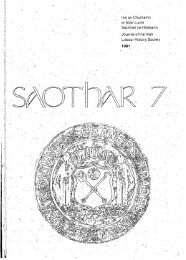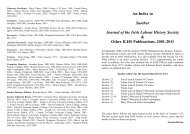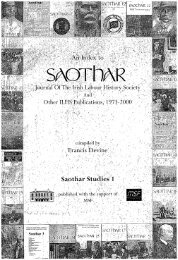You also want an ePaper? Increase the reach of your titles
YUMPU automatically turns print PDFs into web optimized ePapers that Google loves.
66SAOTHAR 13Brothers within the spectacular growth of the institutionalCatholic church in nineteenth century Ireland inorder to give a wider context. For example, in 1831there were only 45 brothers while in 1891 there werenearly 1,000. This great increase did not take place ina vacuum as the increase in the number of priests andparticularly nuns, demonstrated. While the great changeswrought by Paul Cullen are touched on, moderriisationof Irish society at large is not given the attention itdeserves. The inherent equation of Catholicism withNationalism that runs throughout the book can certainlybe questioned. The conflict between Republicanismand Catholicism is not dealt with in any depth,though in this respect it would be unfair to single outColdrey as most Irish historians have flot given thisissue the attention it deserves. At times the writing israther bland and unadventurous: 'In teaching Irishhistory the Brothers were part of a socialisation processthat did something to undermine British hegemony inIreland'. (p. 139) In his conclusion the author writesthat 'The nature of the Brothers' influence is circumstantialand cannot be quantified ... but there is such anaccumulation of circumstantial evidence that a substantialcontribution by the Christian Brothers to thegrowth of Irish national consciousness can confidentlybe inferred'. (p. 271) This is, perhaps, too modest aclaim. The mass of information that Coldrey has un- •earthed has added substantially to our knowledge ofIrish nationalism and for this reason alone this bookdeserves a wide readership.Enda McKayable pointers on the uses of trade journals as a primarysource for the study of social and economic history inIreland. Periodicals such as the Irish Vintner andGrocer, the Farmer's Gazette and the Irish MotorTrader both educated theirreaders and acted as propagandistson their behalf, but yet, compared to newspapersare a very neglected source for social and economichistory.Scientific journals are represented by a case studyof the s'pecialist periodicals of the Geological society ofIreland. TugannCaoilfhionnNic Pha.idmcuntas ginearaltaduinn ar na hlris! Gaeilge i dtr! ranganna, iris!acadula, iris! literartha agus nuachtliin, ach is ar staid nateangan fein agus n! ar chas an leinn atli an beim.David Dickson's brief survey of historical journalsconcentrates more on the market for such publicationsthan on their content. Finally Peter Denman discussesIreland's 'little magazines', part of the definition ofwhich he tells us that the little magazine is 'not a'learned journal' and does not exist to disseminateknowledge within any particular academic or scientificdiscipline'. The same could perhaps be said of 300Years of Irish Periodicals. It is neither book tradehistory, nor intellectual history, nor social history, buttouches on all these and on more. It has the laudable aimof attempting to draw attention to the heritage which islocked away within the covers of the vastrangeoflittleknown periodicals which have been produced in Irelandover the last 300 years. More attention might havebeen given to proof reading and production to eliminatetypographical errors,jumbled paragraphs, and the mostunsuitable quality of paper used in the cover.I"Barbara Hayley & Enda McKay (eds), 300 Years ofIrish Periodicals, (Association of Irish Learned Journals,Gigginstown, Lilliput Press, Dublin, 1987), pp.146, £12.95 hardback, £7.95 paperbackDesigned to accompany an exhibition mounted bythe Association of Irish Learned Journals in 1987, thispublication does not, however, deal exclusively withlearned journals. Rather the seven short essays are amiscellaneous collection on selected aspects of thehistory of Irish periodicals with little uniformity ofpurpose or approach. Apart from Barbara Brown'sessay which analyses the periodical holdings of theRoyal Dublin Society Library in the eighteenth century,the emphasis is on the late nineteenth and twentiethcenturies. Illustrations, mainly title pages of someof the periodicals discussed, occupy a quarter of thebook.Barbara Hayley's essay on periodicals as the voiceof nineteenth century Ireland, despite traditional"nationalistassumptions about the impact of the Union,outlines a fresh approach to source material for understandingthat century, Enda McKay offers some valu-Bernadette Cunningham





